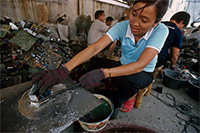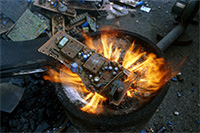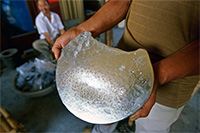Research Identifies U.S. Electronic Waste as Likely Source of Toxic Jewelry Imports from China
Exported Waste Computers and Old Car Batteries May Come Back to Poison our Children
by Ashland University and Basel Action Network
 |
 |
 |
 |
| |
 |
|
| |
Woman cooking circuit boards over pool of molten solder. Thousands of men, woment and children handle imported electronic waste from North America and Japan in this way every day in China. Taizhou, China 2007. |
|
 |
 |
 |
| |
 |
|
| |
Circuit Board being cooked. Taizhou, China 2007 |
|
 |
 |
 |
| |
 |
|
| |
Collected solder from circuit board cooking. Just one of thousands of bucketfuls collected each day in China. Taizhou, China 2007.
Images ©2007 Stuart Isett/www.isett.com |
|
 |
 |
 |
|
| |
11 July 2007 (Ashland, Ohio.) – For Dr. Jeffrey Weidenhamer, a professor of chemistry at Ashland University in Ashland, Ohio, a trip to a local dollar store to buy jewelry samples for his class to analyze, turned into a year-long research project on the global trade in toxic products. The research, soon to be published in two papers in the journal Chemosphere, identifies electronic solders from electronic waste and old car batteries as likely sources for the lead that has been recently discovered in trinket and charm jewelry samples imported from China.
In 2002, the Seattle based Basel Action Network (BAN) in its report “Exporting Harm” revealed that about 80 percent of the electronic waste in the United States that is brought to recyclers is in fact not recycled in the United States but exported to Asia, and especially China where it is melted down in primitive, environmentally damaging conditions including the cooking and melting of computer circuit boards in vast quantity.
Dr. Weidenhamer’s analytical work now implicates electronic waste as a source of the lead that comes back to harm our children in the form of toxic children’s jewelry made in China for the American market. The vast majority of electronic waste found in China comes from North America.
“Unfortunately, this appears to be a case of us reaping what we have sown,” said Weidenhamer. “Recent news paints a picture that China is exporting all kinds of horrors to us, yet our research suggests that we are part of a circle of poison – with our own hazardous waste not only harming the Chinese, but also being recycled into products coming back to harm our children. If so, we must take responsibility to halt these hazardous waste exports.”
Leaded children’s metal jewelry has been the subject of increasing scrutiny in the U.S. since the 2006 lead poisoning death of a young Minnesota boy who swallowed a heart-shaped charm that was later found to contain more than 99 percent lead by weight. Since Jan. 1, there have been 26 recalls of more than 8 million lead-contaminated items of jewelry, toys and clothing, many of them imported from China. The U.S. Consumer Product Safety Commission (CPSC) is currently considering a ban on children’s jewelry containing more than 0.06 percent lead by weight. A decision is expected on this proposal by early 2008.
Dr. Weidenhamer, his students and colleague Michael Clement found that some of the jewelry items they analyzed were composed primarily of lead and tin (the principle components of electronic solders), with minor amounts of copper. They found that copper, which is another component of printed circuit boards, will rapidly move into lead-tin solder when melted. They then analyzed 39 highly leaded jewelry items that contained more than 90 percent lead by weight and found that these contained significant amounts of antimony, a key component of the lead alloy in lead-acid batteries.
For Dr. Weidenhamer, trained as an ecologist, the hypothesis that leaded hazardous wastes might be recycled into leaded products was a natural connection to make. Before analyzing the jewelry his class had analyzed circuit boards for their lead content and studied the global e-waste trade. When his class then found high levels of lead in many of the imported Chinese jewelry items, it seemed reasonable to suspect there might be a link and he contacted BAN who had earlier documented US electronic waste being recycled in hazardous conditions in China.
“In China we wondered what became of the old solder collected by bucketfuls each day by the thousands of workers cooking circuit boards there,” said Jim Puckett, coordinator of BAN. “When Jeff called me after substantiating the hypothesis, it made sense. In a globalized world, pollution knows no borders so the US government’s policy of allowing a free trade in hazardous waste has come back to haunt and hurt us.”
United States is the only developed country in the world that has failed to ratify the Basel Convention, which has been ratified by 170 countries around the world to put strict controls on the import and export of hazardous wastes. In fact, the United States has exempted circuit boards and most electronic waste from the scant laws it does have controlling export of hazardous wastes. Further, they have fought openly against the implementation of the Basel Ban Amendment which forbids the global export of hazardous wastes from developed to developing countries.
Lead is a highly toxic metal that may cause a range of health effects, from behavioral problems and learning disabilities, to seizures and death. Young children are most at risk, because their brains and nervous systems are more sensitive to the effects of lead than adults, and recent research indicates that even small quantities of lead can cause significant neurological injury. While lead paint remains the major hazard to children in the United States, lead’s high toxicity gives reason to eliminate all unnecessary exposure, especially for children.
For more information contact:
Dr. Jeff Weidenhamer, Ashland University, Ohio, +1 (419) 2895281 (office), +1 (419) 6060174 (mobile), jweiden@ashland.edu
Jim Puckett, Basel Action Network, from London +44 7857 242949 (mobile), jpuckett@ban.org
Articles: Chemosphere Article (gally proofs) available at www.ashland.edu/~jweiden
Weidenhamer, J.D., Clement, M.L. “Leaded Electronic Waste is a Possible Source Material for Lead-Contaminated Jewelry” Chemosphere (2007) doi:10.1016/j.chemosphere.2007.04.023
Weidenhamer, J.D., Clement, M.L. “Evidence of Recycling Lead Battery Waste into Highly Leaded Jewelry” Chemosphere (2007) doi:10.1016/j.chemosphere.2007.06.005
Photos: Available at Top Story: www.ban.org
FAIR USE NOTICE. This document contains copyrighted material whose use has not been specifically authorized by the copyright owner. The Basel Action Network is making this article available in our efforts to advance understanding of ecological sustainability and environmental justice issues. We believe that this constitutes a 'fair use' of the copyrighted material as provided for in section 107 of the US Copyright Law. If you wish to use this copyrighted material for purposes of your own that go beyond 'fair use', you must obtain permission from the copyright owner.
More News
|
 |